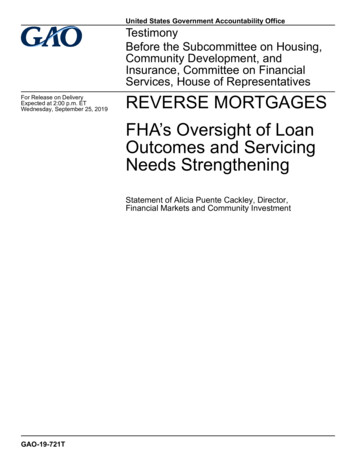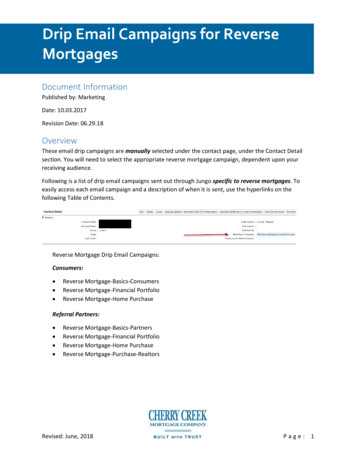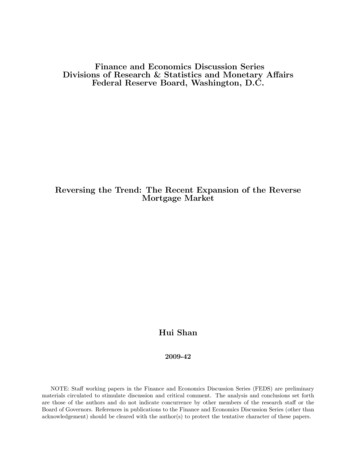
Transcription
United States Government Accountability OfficeTestimonyBefore the Subcommittee on Housing,Community Development, andInsurance, Committee on FinancialServices, House of RepresentativesFor Release on DeliveryExpected at 2:00 p.m. ETWednesday, September 25, 2019REVERSE MORTGAGESFHA’s Oversight of LoanOutcomes and ServicingNeeds StrengtheningStatement of Alicia Puente Cackley, Director,Financial Markets and Community InvestmentGAO-19-721T
LetterLetterChairman Clay, Ranking Member Duffy, and Members of theSubcommittee:I am pleased to be here today to discuss oversight of reverse mortgagesmade under the Home Equity Conversion Mortgage (HECM) program,which is administered by the Federal Housing Administration (FHA) withinthe Department of Housing and Urban Development (HUD). 1 Reversemortgages are loans that allow seniors to convert part of their homeequity into payments from a lender while still living in their homes. Whilereverse mortgages can help senior homeowners meet financial needs,they also can present risks to borrowers.The vast majority of reverse mortgages are made under the HECMprogram. As of the end of fiscal year 2018, FHA had insured more than 1million HECMs, which included about 630,000 active loans and about468,000 terminated loans. HECMs are originated and serviced by privateFHA-approved lenders and servicers. FHA insures these entities againstlosses on the loans and charges borrowers premiums to help cover thepotential cost of insurance claims. While not involved in administering theHECM program, the Consumer Financial Protection Bureau (CFPB)collects consumer complaints about reverse mortgages and supervisesnonbank reverse mortgage lenders and servicers for compliance with,and enforces violations of, federal consumer financial protection laws.HECMs terminate when a borrower repays or refinances the loan or whenthe loan becomes due and payable because the borrower died, moved, ordefaulted (see fig. 1). Defaults occur when borrowers fail to meetmortgage conditions such as paying property charges (for example,property taxes and homeowners insurance) or meeting occupancyrequirements. These borrowers risk foreclosure and loss of their homes ifthey cannot satisfy the debt or correct the condition that resulted in thedefault.1Congress authorized HUD to insure reverse mortgages made under the HECM programin 1988 by adding Section 255 to Title II of the National Housing Act. See Housing andCommunity Development Act of 1987, Pub. L. No. 100-242, § 417 (1988) (codified asamended at 12 U.S.C. § 1715z-20).Page 1GAO-19-721T
Figure 1: HECM Termination Reasons and Repayment AlternativesCertain features of the HECM program can help borrowers delay and, insome cases, avoid foreclosure. If a borrower falls behind on propertycharges, servicers must generally temporarily advance property chargeson a borrower’s behalf (known as servicer advances). However, servicersmay initiate foreclosure proceedings if the borrower does not catch up.Additionally, since 2015, FHA has made program changes to allowservicers to offer foreclosure prevention options to distressed HECMborrowers and nonborrowing spouses of deceased borrowers. 22FHA defines a nonborrowing spouse as the spouse, as determined by the law of thestate in which the borrower and spouse reside or the state of celebration, at the time ofclosing and who is not listed on the mortgage as a borrower.Page 2GAO-19-721T
My testimony summarizes findings from our report on the HECMprogram, which is being released today. 3 Specifically, I will discuss (1)what FHA data show about HECM terminations and the use offoreclosure prevention options; (2) FHA’s assessment and monitoring ofHECM portfolio performance and foreclosure prevention options; (3)FHA’s and CFPB’s oversight of HECM servicers; and (4) FHA’s andCFPB’s collection, analysis, and response to consumer complaints aboutHECMs. For this work, we analyzed FHA loan data and reviewed FHAand CFPB documents on HECM servicer oversight. We also reviewedFHA and CFPB data on consumer complaints related to reversemortgages. We interviewed agency officials, the five largest HECMservicers (representing 99 percent of the market), and legal aidorganizations representing HECM borrowers. We conducted the work onwhich this statement is based in accordance with generally acceptedgovernment auditing standards. More details on our methodology can befound in the issued report.HECM Defaults HaveIncreased, and Use ofForeclosurePrevention Options IsLimitedOur analysis of FHA data found that 272,155 HECMs terminated fromfiscal years 2014 through 2018. The number of terminations rose fromabout 24,000 in fiscal year 2014 to a peak of roughly 82,000 in fiscal year2016, before declining to about 60,000 in fiscal year 2018.In recent years, a growing percentage of HECMs have terminatedbecause borrowers defaulted on their loans. While death of the borroweris the most commonly reported reason why HECMs terminated, thepercentage of terminations due to defaults increased from 2 percent infiscal year 2014 to 18 percent in fiscal year 2018 (see fig. 2). Mostdefaults were due to borrowers not meeting occupancy requirements orfailing to pay property charges. For about 30 percent of terminations, wewere unable to readily determine a termination reason from FHA’s data.3GAO, Reverse Mortgages: FHA Needs to Improve Monitoring and Oversight of LoanOutcomes and Servicing, GAO-19-702 (Washington, D.C.: Sept. 25, 2019).Page 3GAO-19-721T
Figure 2: Reported HECM Termination Reasons, Fiscal Years 2014–2018Note: Due to rounding, figures may not sum to 100 percent.We also found that servicers’ use of foreclosure prevention options forHECM borrowers was limited or FHA did not have readily available datato assess the extent of use. For example, since 2015, FHA has allowedHECM servicers to offer borrowers who are behind on property chargesrepayment plans to help prevent foreclosures, but as of the end of fiscalyear 2018, only about 22 percent of these borrowers had received thisoption. Also, while FHA created a low-balance extension in 2016—whichallows HECM servicers to delay calling a HECM due and payable if theborrower owes less than 2,000 in unpaid property taxes or hazardinsurance—FHA officials told us they do not track how often servicers usethis option. Our analysis of FHA data found that approximately 8,800HECMs that terminated in fiscal years 2014 through 2018 had unpaidproperty charges of less than 2,000 at the time of termination. Some ofthese HECMs may have been eligible for a low-balance extension whenthey terminated.Additionally, we found that it is difficult to estimate the universe of HECMspotentially eligible for mortgagee optional election assignments—anoption to help nonborrowing spouses stay in their homes after aPage 4GAO-19-721T
borrowing spouse dies. Under this option, if required conditions and timeframes are met, the servicer can assign the HECM to FHA. 4 Theassignment defers repayment of the HECM as long as the nonborrowingspouse fulfills certain conditions. According to information generated byFHA, HECM servicers submitted 1,445 requests for mortgagee optionalelection assignments from June 2015 (when FHA made this optionavailable) through September 2018. In total, FHA approved roughly 70percent of the requests and denied the remaining 30 percent. However,nonborrowing spouses were not listed on loan documentation for HECMsoriginated prior to August 4, 2014. As a result, FHA does not know howmany eligible nonborrowing spouses could have, but did not, apply for themortgagee optional election assignment, or how many are potentiallyeligible to apply for it in the future. FHA has begun reaching out to HECMborrowers to inform them of the mortgagee optional election process andask them to self-identify whether there is a nonborrowing spouseassociated with their loan.Weaknesses Exist inHECM TerminationData, PerformanceAssessment, andPortfolio MonitoringFHA’s monitoring, performance assessment, and reporting for the HECMprogram have weaknesses. Since fiscal year 2013, FHA has used theHome Equity Reverse Mortgage Information Technology (HERMIT)system to collect data on the servicing of HECMs, but the system doesnot contain comprehensive and accurate data about the reasons whyHECMs terminate, a key servicing event. According to the HERMIT UserGuide, servicers should provide a reason in HERMIT when they terminatea HECM. However, as noted previously, for about 30 percent of theHECMs that terminated in fiscal years 2014 through 2018, we wereunable to determine the reason for termination. FHA officials told ustermination reasons are available on an individual loan basis in HERMITbut not in an extractable form. FHA does not regularly track and report onHECM termination reasons, due partly to this system limitation.In the report being released today, we are recommending that FHA takesteps to improve the quality and accuracy of HECM termination data.These steps may include updating the termination reasons in the4Under the HECM program, lenders can “assign” a loan to FHA under certaincircumstances and file a claim for the full amount of the loan balance, at which point FHAcontinues to service the assigned loan using a contractor. Lenders assign loans to FHAprimarily when the loan balance reaches 98 percent of the maximum claim amount (thelesser of the appraised value of the home at origination or FHA’s loan limit). However,lenders can also assign loans to FHA under a mortgagee optional election assignment.Page 5GAO-19-721T
HERMIT system for recording these data or updating the HERMIT UserGuide to more clearly instruct servicers how to record terminationreasons. FHA agreed with this recommendation. Comprehensive andaccurate data on HECM terminations would provide FHA with a betterunderstanding of loan outcomes—information FHA and Congress need inorder to know how well the program is helping seniors age in place.FHA also has not established comprehensive performance indicators forthe HECM portfolio and has not regularly tracked key performancemetrics, such as the percentage of HECM terminations due to borrowerdefaults, the proportion of active HECMs with delinquent propertycharges, or the percentage of distressed borrowers who have receivedforeclosure prevention options. For example, HUD’s most recent strategicplan and corresponding performance report do not include HECM-specificperformance indicators, and the last comprehensive evaluation of theHECM program was done in 2000. FHA officials told us they were in theplanning phase for a new evaluation of the program but had not set astart date and did not expect the evaluation to include an analysis of thereasons for HECM terminations or the use of foreclosure preventionoptions for borrowers in default. We are recommending that FHAestablish, periodically review, and report on performance indicators forthe HECM program and examine the impact of foreclosure preventionoptions in the forthcoming HECM program evaluation. FHA agreed withthis recommendation. Better performance assessment could provide FHAimportant information about how well the HECM program is working.Additionally, we found shortcomings in FHA’s internal reporting andanalysis for the HECM program. For example, FHA has not developedinternal reports to comprehensively monitor patterns and trends in loanoutcomes, such as the percentage of HECM terminations due to borrowerdefaults. FHA has generated some reports from HERMIT to help overseethe HECM portfolio, but it has been slow to develop regular andcomprehensive reporting mechanisms. FHA officials told us that whiledata on defaults and foreclosure prevention options have generally beenavailable in HERMIT since 2015, FHA was unable to obtain reports onthese topics until 2018 because of funding limitations with their HERMITsystem contractor. Our review of the regular and ad hoc reports FHA hasreceived from its HERMIT system contractor found that many are lists ofloans that meet criteria and do not provide summary statistics that couldbe used to readily identify patterns or trends in metrics. Further, we foundthe reports required additional analysis to generate meaningfulmanagement information. In the report being released today, werecommend that FHA develop analytic tools, such as dashboards orPage 6GAO-19-721T
watch lists, to better monitor outcomes for the HECM portfolio, such asreasons for terminations, defaults, use of foreclosure prevention options,or advances paid by servicers on behalf of HECM borrowers. FHA agreedwith this recommendation. With more robust program analysis andinternal reporting, FHA would be better positioned to detect and respondto emerging issues and trends in the HECM portfolio.Finally, we found that FHA has not fully analyzed the implications of howit prioritizes foreclosures for HECMs that servicers have assigned to FHA.FHA officials told us the agency generally does not foreclose onborrowers whose HECMs have been assigned to FHA and who are indefault due to unpaid property charges. As a result, defaulted borrowerswhose loans have not been assigned to FHA face a greater risk offoreclosure than defaulted borrowers with FHA-assigned loans. Inaddition, FHA’s process may create a financial incentive for HECMborrowers with assigned loans to not pay their property charges.Therefore, we are recommending that FHA analyze the implications of itsprioritization process. FHA agreed with our recommendation. Suchanalysis would help FHA to better understand how its process forprioritizing foreclosures for assigned loans affects the HECM portfolio,HECM borrowers, neighborhoods, and FHA’s insurance fund.FHA’s Oversight ofServicers andCollaboration onOversight betweenFHA and CFPB AreLimitedFHA’s oversight of HECM servicers has been limited in recent years. FHAhas not performed comprehensive on-site reviews of HECM servicers’compliance with program requirements since fiscal year 2013 and doesnot have current procedures for conducting these reviews. FHA officialssaid they planned to resume the HECM servicer reviews in fiscal year2020, starting with three servicers that account for most of the market.However, as of August 2019, FHA had not developed updated reviewprocedures (they were last updated in 2009) and did not have a riskbased method for prioritizing reviews. In the report being released today,we recommend that FHA develop and implement procedures forconducting on-site reviews of HECM servicers, including a risk-ratingsystem for prioritizing and determining the frequency of reviews. FHAagreed with this recommendation. By resuming HECM servicer on-sitereviews and adopting a risk-rating system, FHA would be betterpositioned to ensure that servicers are following program requirements,including those designed to help protect borrowers.Additionally, we found that while CFPB has examined reverse mortgageservicers and plans to continue doing so, according to CFPB officials thebureau does not share results with FHA because the agencies do notPage 7GAO-19-721T
have an agreement in place to share supervisory information. 5 CFPBofficials said CFPB and FHA had taken initial steps in 2017 towarddeveloping an information-sharing agreement. However, as of August2019, an information-sharing agreement had not been completed.Accordingly, we are recommending that FHA and CFPB work together tocomplete an agreement for sharing the results of CFPB’s examinations ofHECM servicers with FHA. CFPB generally agreed with thisrecommendation, and FHA neither agreed nor disagreed. Sharing theseresults could aid FHA’s oversight of HECM servicers by providingadditional information about the servicers’ performance and operations.CFPB Collects andAnalyzes ConsumerComplaints onReverse Mortgages,but FHA Does NotUse All Available DataCFPB began collecting reverse mortgage consumer complaints inDecember 2011 and has collected about 3,600 complaints since then. 6CFPB officials told us they use consumer complaints as part of theircriteria for selecting entities to examine, including reverse mortgageservicers, and to inform CFPB’s educational publications. We conducteda detailed analysis of a random, generalizable sample of 100 consumercomplaint narratives drawn from all the reverse mortgage complaintsCFPB received in calendar years 2015 through 2018. 7 Based on ourreview of complaint narratives, we found that some of the issuesconsumers cited most commonly were foreclosures, poor communicationfrom lenders or servicers, problems at loan origination, estatemanagement, and unfair interest rates, fees, or costs.FHA collects and records inquiries and complaints about HECMs, and ithas access to CFPB data on reverse mortgage complaints. However,5CFPB oversees reverse mortgage servicers through examinations designed, amongother things, to identify whether servicers engage in acts or practices that violate federalconsumer financial laws. CFPB issued its Reverse Mortgage Examination Procedures in2016 and began conducting examinations in 2017. Consumer Financial ProtectionBureau, Reverse Mortgage Servicing Examination Procedures (Washington, D.C.:October 2016). CFPB’s oversight of reverse mortgage servicers is not limited to thoseparticipating in the HECM program.6CFPB’s Consumer Complaint Database is available through its website nsumer-complaints/. In addition to thisonline forum, CFPB collects complaints via email, mail, phone, fax, or referral fromanother agency.7CFPB issued a report on reverse mortgage consumer complaints it received fromDecember 2011 through December 2014; see Consumer Financial Protection Bureau,Office of Older Americans, Snapshot of Reverse Mortgage Complaints: December 2011–December 2014 (Washington, D.C.: February 2015).Page 8GAO-19-721T
FHA does not use its inquiry and complaint data to help inform HECMprogram policies and oversight, and the way data are collected does notproduce quality information for these purposes. Additionally, we foundthat FHA has not leveraged CFPB complaint data for HECM programoversight.According to FHA officials, FHA’s two main methods for collectingcustomer inquiries and complaints are hotlines operated by the agency’sNational Servicing Center and the FHA Resource Center. 8 From calendaryears 2015 through 2018, the National Servicing Center received about105,000 HECM-related calls. 9 During this same period, the FHAResource Center received 147 HECM-related calls. In April 2019, theFHA Resource Center became the primary entity for collecting, recording,and responding to all HECM-related calls. FHA officials told us theytransferred these responsibilities from the National Servicing Center tothe FHA Resource Center to help improve call management.While this change could help improve customer service, it does not fullyresolve limitations we found in FHA’s approach to collecting andrecording HECM inquiries and complaints that diminish the usefulness ofthe information for program oversight. For example, both the NationalServicing Center and the FHA Resource Center do not collect callinformation in a way that would allow FHA to readily analyze the data forthemes. Specifically, both centers do not reliably differentiate betweeninquiries and complaints—a potentially important distinction fordetermining appropriate agency-level responses. Additionally, while boththe centers collect data on the reason for calls, neither does so in asystematic way that would allow FHA to readily determine how frequentlyissues are being raised. For example, neither center’s data systemscontain standardized categories or menus with options for recordingreasons for calls.8The National Servicing Center is a customer assistance center that works with FHAhomeowners and their lenders or servicers to avoid foreclosure. Customers can submittheir inquiries and complaints via telephone, email, postal mail, or fax. In addition to its twomain methods, FHA receives complaints and inquiries through congressional and WhiteHouse correspondence. FHA officials said complaints received through these channelswere less frequent than complaints received through other methods and sometimesinvolved prospective borrowers who did not meet HECM eligibility requirements.9We use the term “calls” to refer to any inquiry or complaint submitted to FHA and loggedthrough its two main collection methods.Page 9GAO-19-721T
FHA officials said the agency uses complaint and inquiry data to improvecustomer service. However, FHA does not analyze data for otherpurposes that could enhance program oversight, such as determiningwhich HECM servicers and lenders receive the most complaints, targetingentities for on-site reviews, or identifying topics that may need additionalborrower education. In the report being released today, we recommendthat FHA collect and record consumer inquiries and complaints in amanner that facilitates analysis of the type and frequency of the issuesraised. FHA neither agreed nor disagreed with our recommendation. Wealso recommend that FHA periodically analyze available internal andexternal consumer complaint data about reverse mortgages to helpinform management and oversight of the HECM program. FHA agreedwith this recommendation. By improving the collection and use ofconsumer complaint data and better monitoring its own and CFPB’scomplaint data, FHA could improve its ability to detect and respond toemerging consumer protection issues regarding HECMs.Chairman Clay, Ranking Member Duffy, and Members of theSubcommittee, this completes my statement. I would be pleased torespond to any questions that you may have at this time.GAO Contact andStaffAcknowledgments(103793)If you or your staff have any questions about this testimony, pleasecontact Alicia Puente Cackley, Director, Financial Markets andCommunity Investment at (202) 512-8678 or cackleya@gao.gov. Contactpoints for our Offices of Congressional Relations and Public Affairs maybe found on the last page of this statement. GAO staff who made keycontributions to this testimony are Beth Faraguna and Steve Westley(Assistant Directors), Holly Hobbs (Analyst in Charge), Steven Campbell,William Chatlos, John Karikari, Matthew Levie, Marc Molino, JenniferSchwartz, and Tyler Spunaugle.Page 10GAO-19-721T
This is a work of the U.S. government and is not subject to copyright protection in theUnited States. The published product may be reproduced and distributed in its entiretywithout further permission from GAO. However, because this work may containcopyrighted images or other material, permission from the copyright holder may benecessary if you wish to reproduce this material separately.
GAO’s MissionThe Government Accountability Office, the audit, evaluation, and investigativearm of Congress, exists to support Congress in meeting its constitutionalresponsibilities and to help improve the performance and accountability of thefederal government for the American people. GAO examines the use of publicfunds; evaluates federal programs and policies; and provides analyses,recommendations, and other assistance to help Congress make informedoversight, policy, and funding decisions. GAO’s commitment to good governmentis reflected in its core values of accountability, integrity, and reliability.Obtaining Copies ofGAO Reports andTestimonyThe fastest and easiest way to obtain copies of GAO documents at no cost isthrough GAO’s website (https://www.gao.gov). Each weekday afternoon, GAOposts on its website newly released reports, testimony, and correspondence. Tohave GAO e-mail you a list of newly posted products, go to https://www.gao.govand select “E-mail Updates.”Order by PhoneThe price of each GAO publication reflects GAO’s actual cost of production anddistribution and depends on the number of pages in the publication and whetherthe publication is printed in color or black and white. Pricing and orderinginformation is posted on GAO’s website, https://www.gao.gov/ordering.htm.Place orders by calling (202) 512-6000, toll free (866) 801-7077, orTDD (202) 512-2537.Orders may be paid for using American Express, Discover Card, MasterCard,Visa, check, or money order. Call for additional information.Connect with GAOConnect with GAO on Facebook, Flickr, Twitter, and YouTube.Subscribe to our RSS Feeds or E-mail Updates. Listen to our Podcasts.Visit GAO on the web at https://www.gao.gov.To Report Fraud,Waste, and Abuse inFederal ProgramsContact FraudNet:Website: https://www.gao.gov/fraudnet/fraudnet.htmAutomated answering system: (800) 424-5454 or (202) 512-7700CongressionalRelationsOrice Williams Brown, Managing Director, WilliamsO@gao.gov, (202) 512-4400,U.S. Government Accountability Office, 441 G Street NW, Room 7125,Washington, DC 20548Public AffairsChuck Young, Managing Director, youngc1@gao.gov, (202) 512-4800U.S. Government Accountability Office, 441 G Street NW, Room 7149Washington, DC 20548Strategic Planning andExternal LiaisonJames-Christian Blockwood, Managing Director, spel@gao.gov, (202) 512-4707U.S. Government Accountability Office, 441 G Street NW, Room 7814,Washington, DC 20548Please Print on Recycled Paper.
the Department of Housing and Urban Development (HUD). 1 Reverse mortgages are loans that allow seniors to convert part of their home equity into payments from a lender while still living in their homes. While reverse mortgages can help senior homeowners meet financial needs, they also can present risks to borrowers.










